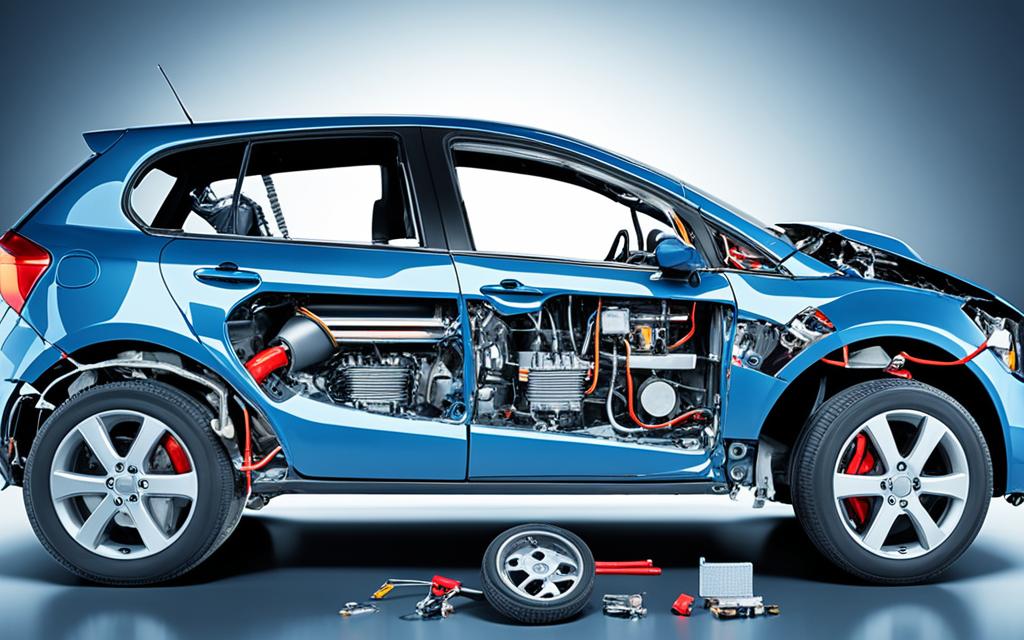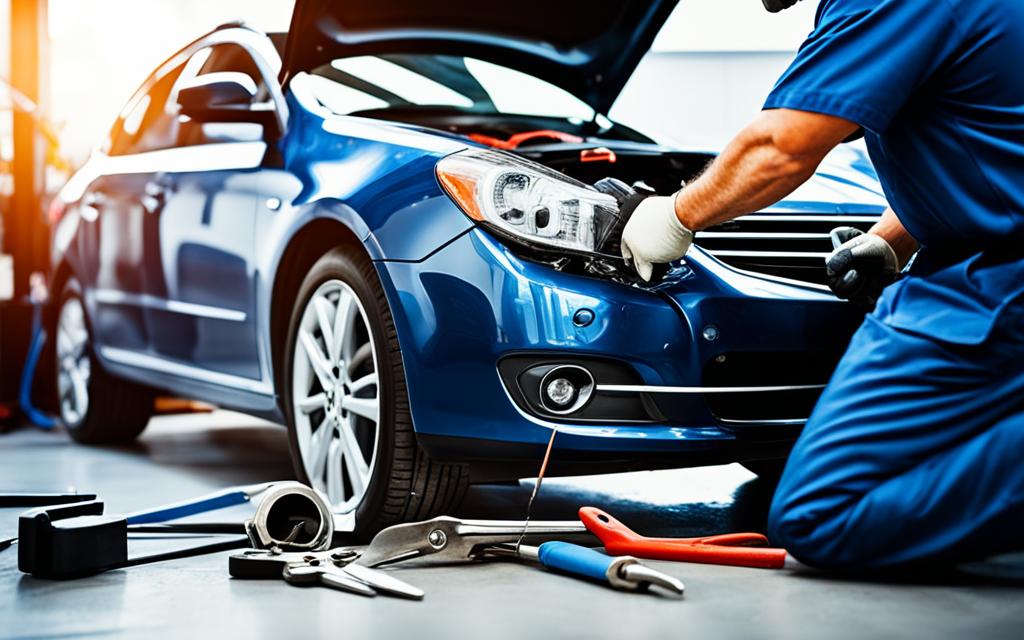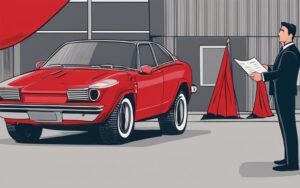Are you wondering, “Does car insurance cover repairs?” Well, you’ve come to the right place! In this article, we will provide a comprehensive explanation of the coverage your auto insurance policy offers for repairs. Whether you’ve been involved in an accident or need repairs due to other circumstances, understanding your auto insurance repair coverage is essential.
When it comes to auto insurance repair coverage, there are different types of policies to consider. Collision coverage, comprehensive coverage, and liability coverage all provide varying levels of repair coverage. It’s important to know which policy you have and what repairs it covers.
We will delve into each type of coverage, discussing what repairs are typically covered under collision coverage and how comprehensive coverage goes beyond collision-related damages. Additionally, we will touch on liability coverage and its limitations in terms of repair coverage.
It’s also essential to be aware of factors that can affect repair coverage, such as deductibles and policy limits. Your deductible is the amount you’re responsible for paying before your insurance coverage kicks in, while policy limits define the maximum amount your insurance will cover.
Furthermore, we’ll cover important considerations like maintenance and wear & tear. Understanding what is and isn’t covered regarding regular maintenance expenses can help you manage your expectations and plan accordingly.
If you’ve ever wondered if you have the freedom to choose your mechanic for repairs, we’ll answer that question too. Most auto insurance policies allow policyholders to select their preferred repair shop, but it’s essential to be aware of any requirements or stipulations set by the insurance company.
Finally, we’ll guide you through the process of filing a claim for repairs, discussing the necessary information, documentation, and steps involved. We’ll also touch upon additional coverage options and endorsements that can further enhance your repair coverage under your auto insurance policy.
By the end of this article, you’ll have a comprehensive understanding of auto insurance repair coverage, empowering you to make informed decisions and choose the right policy for your needs.
Key Takeaways:
- Auto insurance policies offer repair coverage, but the extent of coverage depends on the type of policy you have.
- Different types of coverage, such as collision coverage and comprehensive coverage, cover various types of repairs.
- Factors like deductibles and policy limits can impact repair coverage.
- Regular maintenance and wear & tear expenses are typically not covered by auto insurance policies.
- You can usually choose your preferred repair shop, but be aware of any requirements set by your insurance company.
Types of Auto Insurance Policies
When it comes to auto insurance, there are several types of policies available, each offering different levels of coverage for repairs. Understanding these policies is essential to ensure you select the right one for your needs. Let’s take a closer look at the three main types of auto insurance policies: collision coverage, comprehensive coverage, and liability coverage.
Collision Coverage
Collision coverage is designed to protect you against repair costs resulting from an accident, regardless of who is at fault. This policy covers damages to your vehicle caused by a collision with another vehicle or object. With collision coverage, you can have peace of mind knowing that the repair expenses will be taken care of, helping you get your vehicle back on the road quickly. Remember, collision coverage usually requires a deductible, which is the amount you’ll need to pay out of pocket before the insurance kicks in.
Comprehensive Coverage
Comprehensive coverage offers a broader scope of protection compared to collision coverage. It covers repair costs for damages to your vehicle resulting from non-collision events such as theft, vandalism, fire, natural disasters, and animal collisions. By having comprehensive coverage, you can have financial protection even in situations where a collision is not involved. Similar to collision coverage, comprehensive coverage typically requires a deductible.
Liability Coverage
Unlike collision and comprehensive coverage, liability coverage does not directly cover your vehicle’s repair costs. Instead, it protects you from liability if you are at fault in an accident that causes damage to someone else’s property or injuries to others. Liability coverage is a legal requirement in most states, and while it may not directly cover your vehicle’s repairs, it provides crucial financial protection in case you cause an accident.
In a nutshell, collision coverage takes care of damages resulting from collisions with others or objects, comprehensive coverage offers protection against non-collision damages, and liability coverage ensures financial protection against damages caused to others.
Now that you have a better understanding of the different types of auto insurance policies and how each provides coverage for repairs, you can make an informed decision when selecting the right policy for your needs.
Collision Coverage and Repairs
In the unfortunate event of an accident, collision coverage plays a crucial role in helping cover the repair costs of your vehicle. This type of auto insurance coverage protects you from expenses associated with damages resulting from a collision with another vehicle or object.
Under collision coverage, various types of repairs are typically covered, ensuring your vehicle is restored to its pre-accident condition. These repairs can include:
- Bodywork: Repairing dents, scratches, and other damages to the exterior of your vehicle.
- Frame Repair: Addressing any structural damage to the frame or chassis of your vehicle.
- Mechanical Repairs: Fixing any mechanical components damaged as a result of the collision.
Having collision coverage provides you with the peace of mind that, in the event of an accident, the repair costs will be covered up to the policy’s limits. Remember to carefully review your policy to understand the specific coverage details and any deductible you may need to pay before the insurance kicks in.
Collision coverage is essential for protecting your investments and minimizing the financial burden of repair costs resulting from accidents. By having this coverage in place, you can be confident that your vehicle will be repaired, allowing you to get back on the road quickly.
Comprehensive Coverage and Repairs
Comprehensive coverage is a vital aspect of auto insurance repair coverage. It offers protection for damages that are not caused by a collision. This type of coverage ensures that your vehicle is safeguarded from a variety of risks, including theft, vandalism, weather-related damages, and even animal collisions.
With comprehensive car insurance repairs, you can have peace of mind knowing that your policy will cover the cost of necessary repairs in these unfortunate situations. Whether your car is stolen or damaged in a storm, comprehensive coverage provides the financial support you need to restore your vehicle to its previous condition.
- Theft: If your vehicle is stolen, comprehensive coverage will help cover the cost of repairs or a replacement, depending on the circumstances and the policy specifics.
- Vandalism: Acts of vandalism, such as keying or malicious damage, can be costly to repair. Fortunately, comprehensive coverage will ensure that the repairs are covered, so you don’t have to bear the financial burden alone.
- Weather-related damages: From hailstorms to flooding, weather events can cause significant damage to your vehicle. Comprehensive coverage helps cover the cost of repairs, providing you with the necessary support to get your car back on the road.
- Animal collisions: Collisions with animals, such as deer or pets, can cause extensive damage to your vehicle. Comprehensive coverage typically covers the necessary repairs, so you can get your car repaired and back on the road quickly.
It’s important to note that comprehensive coverage has a deductible, which is the amount you must pay out of pocket before your insurance kicks in. The specific deductible amount varies depending on your policy, so be sure to review your insurance contract to understand your financial responsibility.
| Damage Type | Repair Coverage |
|---|---|
| Theft | Full coverage for repair costs or replacement |
| Vandalism | Complete coverage for repair costs |
| Weather-related damages | Comprehensive support for necessary repairs |
| Animal collisions | Full coverage for repair costs |
Having comprehensive coverage is crucial for protecting your vehicle against a wide range of potential damages. From theft to weather-related incidents, this coverage provides the necessary support to handle repair costs and restore your vehicle to its former condition.
Limits and Deductibles
When it comes to auto insurance repair coverage, the limits and deductibles you choose can have a significant impact on your overall protection. Let’s take a closer look at how these factors can affect repair costs covered by your auto insurance policy.
Higher deductibles, lower premiums: One key consideration is the deductible amount you select. A deductible is the amount you have to pay out of pocket before your insurance kicks in to cover the rest of the repair costs. Generally, the higher the deductible you choose, the lower your premium will be. This means you pay less each month for your insurance. However, keep in mind that with a higher deductible, you’ll have a higher out-of-pocket expense if you need to make a repair claim.
Choosing the right deductible: It’s essential to strike a balance between your premium and your deductible. Consider your financial situation and how much you can comfortably afford to pay upfront in case of an accident or damage to your vehicle. If you have a healthy emergency fund and can handle a higher deductible, it may be worth opting for a higher deductible to save on your premium. On the other hand, if paying a higher deductible would strain your budget, a lower deductible may be a more suitable choice.
Evaluating coverage limits: In addition to deductibles, you should also assess the coverage limits of your auto insurance policy. Coverage limits refer to the maximum amount your insurance provider will pay for repairs. If your repair costs exceed these limits, you may be responsible for covering the remaining expenses. It’s crucial to carefully review your policy documents and ensure that the coverage limits adequately protect you and your vehicle.
Balancing protection and affordability: Finding the right balance between repair coverage and affordability is key. While opting for higher limits can provide greater peace of mind, it can also result in higher premiums. Evaluate your needs, budget, and the value of your vehicle to determine the ideal coverage limits that strike a balance between protection and cost.
Consulting with your insurance provider: To help you make informed decisions about deductible amounts and coverage limits, we recommend reaching out to your insurance provider. They can provide personalized guidance based on your unique circumstances and specific policy details.
Remember, understanding how limits and deductibles impact auto insurance repair coverage is crucial to ensure you have the right level of protection without stretching your budget too thin. Now, let’s explore some other important factors related to repair coverage under your auto insurance policy.

Maintenance and Wear & Tear
In this section, we will explore the topic of car maintenance and wear & tear in relation to auto insurance coverage. It is important to understand that regular maintenance and expenses associated with general wear & tear are typically not covered by car insurance policies. However, there are instances where these costs may be covered if they are a result of a covered event or accident.
Car insurance is designed to protect against unexpected events and accidents, not routine upkeep. It is the responsibility of the vehicle owner to maintain their car and handle routine maintenance costs.
However, if your car incurs damage due to a covered event like a collision or theft, which results in the need for repairs, your car insurance policy may cover the necessary repairs.
It’s important to note that wear & tear, such as mechanical breakdowns or deterioration of parts over time, is typically considered a normal part of car ownership and maintenance. These costs are generally not covered by car insurance policies.
For instance, if your transmission fails due to normal wear & tear, you will likely be responsible for the repair or replacement costs. Similarly, if your brakes need replacing or your tires wear out, these are also considered maintenance expenses that would not typically be covered by car insurance.
However, it’s always a good idea to review your specific auto insurance policy as there may be certain coverage options or endorsements available that provide limited coverage for wear & tear costs. Check with your insurance provider to see if there are any additional coverage options that can help minimize the out-of-pocket expenses associated with wear & tear.
Mechanic Choice
When it comes to getting your vehicle repaired, it’s important to know that most auto insurance policies allow you to choose your preferred mechanic. This gives you the freedom to select a trusted and reliable professional who can handle the necessary repairs.
Having the choice of mechanic is beneficial for several reasons. Firstly, you can work with someone you trust and have confidence in, knowing that your vehicle is in capable hands. Secondly, you may have established a relationship with a particular mechanic over the years and feel more comfortable having them handle the repairs. Lastly, selecting your own mechanic allows you to have direct communication with the person working on your vehicle, ensuring that any concerns or questions are addressed promptly.
However, it’s important to note that some insurance companies may have specific stipulations or requirements when it comes to selecting a mechanic. For example, they may have a list of approved repair providers and require you to choose from that list. This is typically done to ensure that the repairs meet their quality standards and warranties.
If you have a preferred mechanic that you’d like to use, it’s a good idea to check with your insurance provider to see if they allow you to choose your own mechanic and if there are any specific guidelines to follow.
Benefits of Choosing Your Own Mechanic:
- Trust in the expertise and reputation of your chosen mechanic.
- Established relationship and better understanding of your vehicle’s history.
- Direct communication with the mechanic for prompt resolution of concerns.
Insurance Company Requirements:
Some insurance companies may have a list of approved repair providers.
Check with your insurance provider for any specific guidelines to follow.
| Pros | Cons |
|---|---|
| You can choose a trusted and reliable mechanic. | Some insurance companies may have restrictions or requirements. |
| You have direct communication with the person handling the repairs. | There may be limitations on the coverage offered by the chosen mechanic. |
| You can have peace of mind knowing your vehicle is in capable hands. | Choosing your own mechanic may not be the most convenient option based on location or availability. |
Filing a Claim for Repairs
When you encounter an accident or damage to your vehicle, filing a claim with your auto insurance provider is essential to cover the repair costs. To ensure a smooth and efficient claims process, it’s crucial to gather the necessary information and have the required documentation ready. Let’s walk through the steps involved in filing a claim for repairs and getting your vehicle back on the road.
Step 1: Report the Incident
The first step in filing a claim is to report the incident to your auto insurance provider as soon as possible. Most insurance companies have a dedicated claims hotline or online portal where you can report the details of the accident or damage. Be prepared to provide the following information:
- Date and time of the incident
- Location of the incident
- Description of what happened
- Names and contact information of any other involved parties
- Police report number, if applicable
Step 2: Document the Damage
Take photographs of the damage to your vehicle from multiple angles. This visual evidence can support your claim and help the insurance adjuster assess the extent of the repairs required. Additionally, it’s a good practice to gather any relevant supporting documentation, such as receipts for towing services or repair estimates from reputable mechanics.
Step 3: Contact your Insurance Adjuster
After reporting the incident, your auto insurance provider will assign an insurance adjuster to your claim. The adjuster will be responsible for evaluating the damage, determining coverage, and estimating the repair costs. It’s essential to establish clear communication with your adjuster and provide them with any requested information promptly.
Step 4: Obtain Repair Estimates
Once you have contacted your insurance adjuster, they may request repair estimates from authorized repair shops. It’s advisable to obtain multiple estimates from reputable mechanics to ensure fair and accurate assessments of the repair costs. These estimates will help determine the amount covered by your auto insurance policy.
Step 5: Follow Insurance Company Guidelines
Each auto insurance provider may have specific guidelines or procedures for the repair process. It’s crucial to familiarize yourself with these guidelines and adhere to them when selecting a repair shop and authorizing repairs. Failure to follow the insurance company’s instructions may result in delays or potential complications in receiving coverage for the repair costs.
Step 6: Paying the Deductible
Once the repair costs are determined, you will be responsible for paying the deductible specified in your auto insurance policy. The deductible is the amount you agree to pay out of pocket before your insurance coverage kicks in. It’s essential to budget for this expense and be aware of the deductible amount for your policy.
Step 7: Authorize the Repairs
After receiving the repair estimates and payment details, you can authorize the chosen repair shop to proceed with the necessary repairs. It’s advisable to select a reputable and authorized repair facility to ensure quality workmanship and adherence to any warranty requirements.
Step 8: Keep Documentation
Throughout the claims process, it’s vital to keep copies of all communication, documentation, and receipts related to the repairs. These records will serve as evidence and may be required for future reference or potential audits.
By following these steps and working closely with your auto insurance provider, you can smoothly navigate the claims process and have your repair costs covered. Remember, each insurance company may have specific procedures, so it’s essential to consult your policy or contact your provider for personalized guidance.
Factors Affecting Repair Coverage
When it comes to auto insurance repair coverage, there are several factors that can affect the extent of coverage provided by your policy. It’s important to understand these factors to ensure that you have the necessary protection in place for unexpected repair costs. Let’s explore some of the key factors that can impact your repair coverage:
Policy Exclusions
Every auto insurance policy has exclusions that define what repairs are not covered. It’s crucial to carefully review your policy to understand the specific exclusions that may limit your repair coverage. Common exclusions may include wear and tear, mechanical breakdowns, and modifications not disclosed to the insurer.
Prior Claims History
“Your prior claims history can impact your repair coverage.”
Insurance companies take into account your prior claims history to assess the risk associated with providing repair coverage. If you have a history of frequent claims or a significant, costly claim in the past, it may impact the repair coverage offered by your policy. This is because insurers consider the likelihood of future claims when determining your coverage options and premiums.
Age and Condition of the Vehicle
The age and condition of your vehicle can also affect repair coverage. Older vehicles or those in poor condition may have limited coverage options due to the increased risk of mechanical failures and higher repair costs. It’s important to discuss these factors with your insurance provider to ensure you have adequate coverage for your specific vehicle.
Special Considerations for Classic or Vintage Cars
Classic or vintage cars often require specialized repair coverage due to their unique value and scarcity of parts. If you own a classic or vintage car, it’s crucial to have a policy that offers comprehensive repair coverage tailored to your vehicle’s specific needs.
These are just a few of the factors that can impact your auto insurance repair coverage. It’s essential to review your policy and discuss any concerns with your insurance provider to ensure you have the necessary protection for your vehicle repairs.

| Factors Affecting Repair Coverage | Impact |
|---|---|
| Policy Exclusions | Limit coverage for specific repairs |
| Prior Claims History | May affect coverage options and premiums |
| Age and Condition of the Vehicle | Older vehicles or poor condition may have limited coverage |
| Special Considerations for Classic or Vintage Cars | Unique repair coverage needs for classic or vintage cars |
Additional Coverage and Endorsements
While basic auto insurance policies provide essential repair coverage, there are additional coverage options and endorsements that can further enhance your vehicle insurance repair policy. These add-ons can offer valuable benefits and peace of mind, ensuring you’re protected from unforeseen expenses and inconveniences. Let’s explore some of these options:
Rental Car Reimbursement
One popular endorsement is rental car reimbursement. In the event that your vehicle requires repairs after an accident or covered event, this coverage provides reimbursement for the cost of a rental car. It allows you to continue with your daily activities while your car is being repaired, minimizing disruptions to your routine.
Roadside Assistance
Another valuable add-on is roadside assistance coverage. This endorsement provides support in case of emergencies, such as a flat tire, dead battery, or running out of fuel. With roadside assistance, help is just a phone call away, ensuring you’re never stranded on the side of the road.
OEM Parts Coverage
When it comes to repairs, some policyholders prefer the use of Original Equipment Manufacturer (OEM) parts. OEM parts are designed by the vehicle manufacturer and are an exact match for your vehicle’s specifications. With OEM parts coverage, your insurance policy can help cover the cost of these parts, ensuring your vehicle is repaired with top-quality components.
By considering these additional coverage options and endorsements, you can customize your auto insurance policy to best fit your needs. It’s important to review your policy carefully and discuss these options with your insurance agent to ensure you have the right level of coverage for your vehicle and personal circumstances.
| Additional Coverage Options | Benefits |
|---|---|
| Rental Car Reimbursement | Provides reimbursement for rental car expenses while your vehicle is being repaired. |
| Roadside Assistance | Offers 24/7 support for emergencies such as flat tires, dead batteries, or running out of fuel. |
| OEM Parts Coverage | Helps cover the cost of Original Equipment Manufacturer (OEM) parts for repairs. |
Shop Around for Repair Coverage
When it comes to securing the right auto insurance policy that offers comprehensive repair coverage, shopping around is key. Comparing quotes and evaluating coverage options can help you find the best policy for your needs.
Here are some essential tips for finding the right vehicle insurance repair policy:
- Obtain multiple quotes from different insurance providers to compare coverage options and prices.
- Consider the repair costs covered by auto insurance policies when reviewing the quotes.
- Pay attention to the deductible amounts and how they may affect your out-of-pocket expenses for repairs.
- Review the policy limits to ensure they are sufficient to cover potential repair costs.
- Check if the policy offers additional coverage options, such as rental car reimbursement or roadside assistance, which can be valuable in case of repairs.
- Verify if the insurance company allows you to choose your preferred repair shop for repairs.
| Insurance Provider | Repair Coverage | Deductible Amount | Additional Coverage | Choice of Repair Shop |
|---|---|---|---|---|
| ABC Insurance | Covers repair costs for damages caused by accidents, theft, and weather events | $500 | Rental car reimbursement, roadside assistance | Policyholder’s choice |
| XYZ Insurance | Provides repair coverage for collision damages and vandalism | $1,000 | – | Selected network of repair shops |
| 123 Insurance | Covers repair costs for accidents, fire, and other covered events | $250 | Rental car reimbursement, OEM parts coverage | Policyholder’s choice |
By carefully considering these factors and comparing the repair coverage offered by different insurance providers, you can make an informed decision and ensure your vehicle is adequately protected. Remember, finding the right vehicle insurance repair policy is essential in minimizing repair costs covered by auto insurance and providing peace of mind.
Conclusion
In conclusion, understanding the extent of repair coverage provided by your auto insurance policy is crucial when it comes to protecting yourself and your vehicle. We have explored the various aspects of auto insurance repair coverage and answered the question “Does car insurance cover repairs?”
By reviewing your policy and considering your specific needs, you can ensure that you have the necessary coverage for repair costs. It is important to conduct comprehensive research and seek a thorough understanding of the repair costs covered by different types of auto insurance policies.
Rather than making assumptions, take the time to review your policy documentation and consult with your insurance provider to clarify any uncertainties. This will enable you to make an informed decision that aligns with your budget and protects you from unexpected repair expenses.
FAQ
Does car insurance cover repairs?
Yes, car insurance can cover repairs depending on the type of policy you have. Different policies provide varying degrees of repair coverage.
What types of auto insurance policies provide repair coverage?
There are several types of auto insurance policies that offer repair coverage, including collision coverage, comprehensive coverage, and liability coverage.
What repairs are typically covered under collision coverage?
Collision coverage usually covers repairs for damages resulting from an accident, including bodywork, frame repair, and mechanical repairs.
What repairs are typically covered under comprehensive coverage?
Comprehensive coverage provides repair coverage for damages not caused by a collision, such as theft, vandalism, weather-related damages, and animal collisions.
How do limits and deductibles affect repair coverage?
The limits and deductibles you choose for your auto insurance policy can impact repair coverage. Higher deductibles can lower your premium, but increase your out-of-pocket expenses for repairs.
Does car insurance cover regular maintenance and wear & tear?
No, auto insurance policies typically do not cover expenses related to regular maintenance and general wear and tear unless caused by a covered event or accident.
Can I choose my preferred mechanic for repairs?
Yes, most auto insurance policies allow policyholders to choose their preferred mechanic for repairs. However, there may be stipulations or requirements set by the insurance company.
How do I file a claim for repairs?
To file a claim for repairs, you will need to gather necessary information, provide documentation, and follow the steps outlined by your auto insurance provider in the claims process.
What factors can affect repair coverage?
Several factors can impact repair coverage under your auto insurance policy, including policy exclusions, prior claims history, the age and condition of the vehicle, and any special considerations for classic or vintage cars.
Are there additional coverage options for repair coverage?
Yes, there are additional coverage options and endorsements available that can enhance repair coverage under your auto insurance policy, such as rental car reimbursement, roadside assistance, and OEM parts coverage.
How important is it to shop around for repair coverage?
It is crucial to shop around for the right auto insurance policy that offers comprehensive repair coverage. Comparing quotes, evaluating coverage options, and finding the best policy for your needs can help ensure you have the necessary protection for your vehicle.








